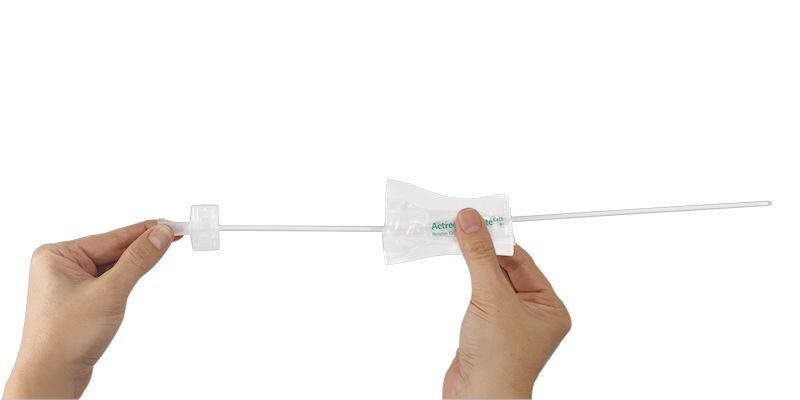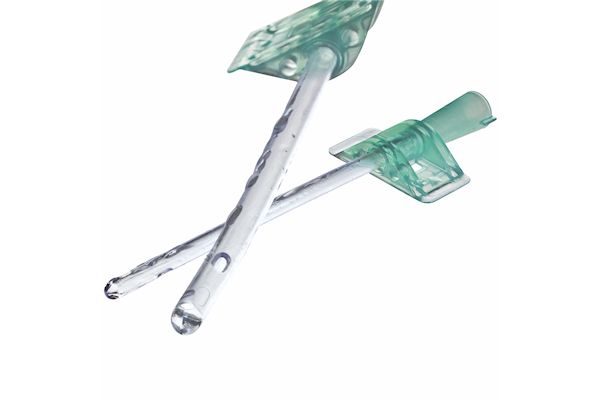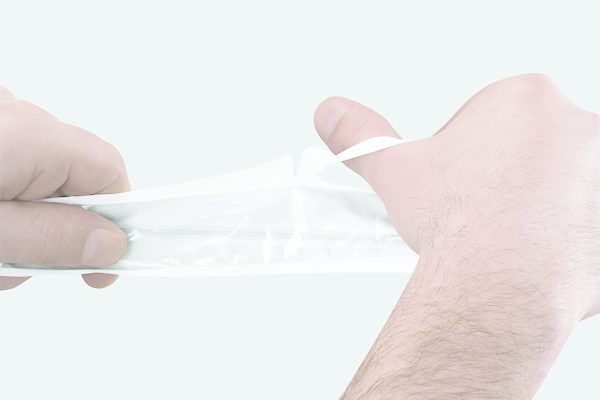Technological advances have brought many benefits to indwelling catheters, but they have also complicated the understanding of healthcare professionals and patients. There are now several types of catheters, designed to suit the injury, condition, specific circumstances and needs of the user.
If you are about to or have recently started using intermittent catheters, it is almost certain that you may be ignoring important parameters that can make daily catheterization easier and faster. Traumacare follows modern standards of urological nursing care and presents you with comprehensive information and practical instructions for all types of intermittent catheters.

What is an intermittent catheter?
Like any urinary catheter, disposable intermittent catheters are thin, flexible tubes used to help people who cannot empty their bladder on their own using the intermittent catheterization method , a particularly simple technique that can be taught by nursing staff to the patient so that he can perform it completely alone, approximately 4-6 times a day, as if he were going to the toilet normally.
The intermittent catheter is a disposable catheter that is inserted through the urethra, reaching the bladder, and then removed once it is empty. In the past, there were also intermittent, reusable catheters, but they have been abandoned as they present an increased risk of urinary tract infections and unnecessarily hinder the user's mobility. Today, intermittent self-catheterization is a simple daily habit for people with incontinence, urinary retention, diabetes, and a number of diseases that cause bladder dysfunction .
Technical Characteristics of Disposable Intermittent Catheters
Catheter length
The types of disposable intermittent catheters are now specifically designed for each gender to respond to the anatomical differences between men and women, but there are also special designs for children.
- Male Catheters 40-45cm
- Female catheters: 20-26cm
- Pediatric catheters: 20-25cm
This differentiation in length is extremely important, since the shorter length of intermittent catheters for women and children allows for easy use and placement without folding or kinking, while the longer length of men's catheters ensures complete drainage of the bladder.
Although some companies produce pediatric catheters, the length is essentially the same as that of women's, and so, most of the time, women's intermittent catheters are also used for children without any problems at all .
Catheter size
Since the intermittent catheter is a tube intended to allow free flow of urine without causing damage to the urethra, the selection of the appropriate size is determined by the outer diameter of the conduit.
The diameter of all catheters is measured in millimeters according to the French scale or the French measurement system and is most often denoted by Fr or CH (in honor of Joseph-Frédéric-Benoît Charrière , who created the French scale). Other times it is also denoted as F, FG, Ch .
Sizes range from 6 to 24Fr, with women typically using 10-14Fr and men typically using 12-14Fr. The larger sizes are used to treat strictures and other complications.
For immediate distinction and identification of the size of an intermittent catheter, its tip is color-coded.
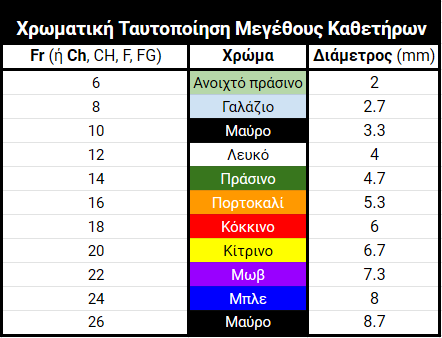
Catheter holes
There are usually two holes at the tip of intermittent urinary catheters, positioned side by side or across from each other. Larger catheters do not necessarily have larger holes than smaller ones.

Catheter tips
Nelaton catheter
The Nelaton catheter is the most common. It is completely straight and flexible with a soft rounded tip. Most often it has two side holes.
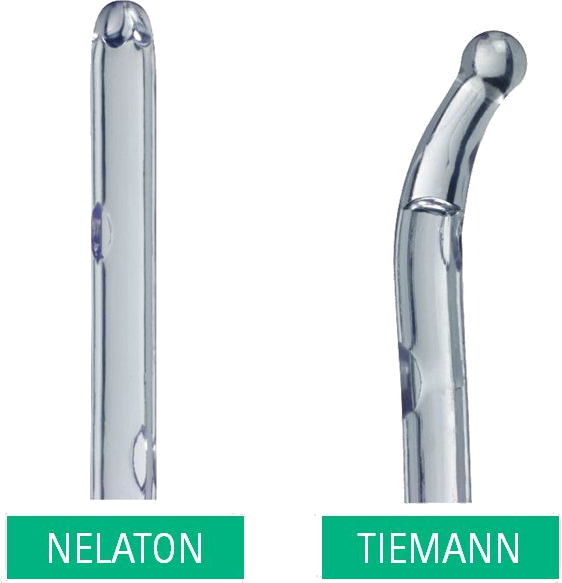
Tiemann catheter
Tiemann catheters (also known as Coudé catheters ) are more rigid than Nelaton catheters and are slightly bent at the tip, allowing the tube to bypass problem areas, and they usually have three urine drainage holes.
They are often preferred when the user feels discomfort using a Nelaton catheter but are the appropriate choice in people with urethral stricture, prostate hyperplasia, prostate surgery, radiation to the pelvic area, false passages or urethral trauma.
Construction material
The material an intermittent catheter is made of can play a role in whether or not it will suit your needs. Beyond that, the two factors you should definitely watch out for are catheters containing latex and plasticizers since they are not only unsuitable for people with allergies but long-term exposure to these materials has an increased chance of causing these allergies .
Vinyl (PVC)
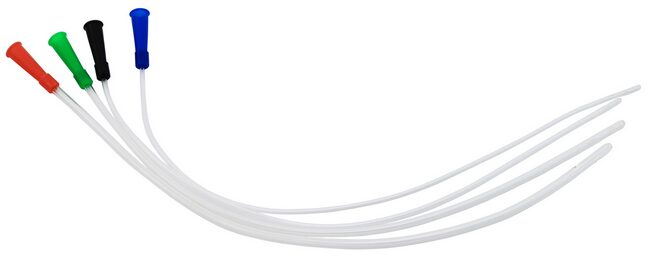
Vinyl, also known as PVC (polyvinyl chloride) , remains the most popular disposable catheter material. They are generally clear, stable, and flexible, but their flexibility depends on the manufacturer and the composition (which often contains latex). Of course, most manufacturers use plasticizers to make vinyl catheters more flexible.
- Stable and flexible
- Transparent so you can see the exit
- Compatible with the French scale
- Some disposable vinyl catheters do not have a funnel
- Only some vinyl catheters are latex-free
Latex (red)

Rubber latex is heat sensitive, meaning the disposable catheter is easily heated by ambient temperature and becomes flexible. Many people, of course, experience difficulties during insertion.
- We find them in red, brown or orange, depending on the manufacturer.
- They are opaque.
- There is no color coding according to the French scale
- They are prohibited for people with allergies or sensitivity to latex.
Silicone
Silicone catheters are becoming increasingly popular over time.
- Extremely smooth material
- The flexibility of silicone catheters lies between latex and vinyl.
- Often latex-free and less often plasticizer-free (DEHP)
- Clear for easy observation of urine output
- Several manufacturers use the French scale color coding
Of course, there are even more modern catheter manufacturing materials, such as the thermoplastic polyolefin used by B Braun, with clearly better properties than all of the above .
Catheter lubrication
The purpose of lubrication is to reduce friction during insertion and removal of the disposable intermittent catheter, thereby protecting the sensitive urethra from irritation and injury.
Unfertilized
There are plain catheters, usually made of latex, vinyl (PVC) or silicone, which are available with a separate gel or other lubricant and are usually used in the hospital. Unlubricated latex catheters are not suitable for everyone and are contraindicated for those with a latex allergy. It is worth noting once again that even if someone does not have a latex allergy, there is a high chance that they will develop one if they are exposed to it frequently.
These are the combinations of lubricants used in this case.
• Lubricants without anesthetic (lignocaine, lidocaine and/or chlorhexidine)
• Lubricants with chlorhexidine (antiseptic)
• Lubricants with anesthetic lignocaine/lidocaine
• Lubricants with anesthetic lignocaine/lidocaine and chlorhexidine
• Water and glycerin lubricants
Hydrophilic self-lubricating and ready-lubricated catheters
Hydrophilic catheters are characterized by having a polymer coating layer, which absorbs and binds water to the surface of the catheter up to ten times its weight. This results in a really thick, smooth and slippery surface that causes minimal friction between the catheter surface and the urethral mucosa during insertion. The hydrophilic coating layer remains intact during insertion and ensures lubrication of the urethra along its entire length.
Today, there is a wide variety of hydrophilic coated products. Some products require the addition of water for 30 seconds to activate the coating of the catheter, while others are sold pre-packaged with water or saline. There are also self-lubricating catheters that use an inert, transparent, water-soluble gel that automatically lubricates the catheter as it is advanced from the packaging that contains it. The only problem with all of these disposable hydrophilic catheters is that they “drip” which means there is a high chance of getting dirty.
But there is an even better solution that does not make a mess and does not create a mess with ready-made lubricated catheters . So you do not need to do anything but follow the instructions for use of the product you choose. A typical example of the technology of pre-lubricated disposable catheters is the Actreen series from B Braun .
